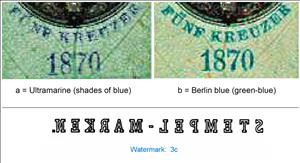Stamp: Stempel Marke 1870 1/2kr (Austria 1870)
Stempel Marke 1870 1/2kr (Austria 1870)
01 March (Austria ) within release Revenues : Stempelmarke 1870 goes into circulation Stamp Stempel Marke 1870 1/2kr face value ½ Austro-Hungarian kreuzer
| Stamp Stempel Marke 1870 1/2kr in catalogues | |
|---|---|
| POFIS: | POF: AT KZ149b |
Stamp is square format.
4th issue. Face value in words and year 1870 (Typography): b= Berlin blue (blue-green, sharp edges of letters and numbers; height of numbers 3 mm). Perforation line 8 1/2 - 11; Exceptionally line 12 1/2 and 13. Watermark: 3c ("STEMPEL-MARKEN" - letters inside uninterrupted by lines. Height 24 mm, wider "M" - 27 to 30 mm). Printing Method: 1. Circular medallion and numerical face value - PHOTOGRAVURE (copperplate printing) + 2. Pattern background (leaf of tree) - TYPOGRAPHY.Also in the issue Revenues : Stempelmarke 1870:
- Stamp - Stempel Marke 1870 1/2kr face value ½;
- Stamp - Stempel Marke 1870 10fl face value 10;
- Stamp - Stempel Marke 1870 10fl face value 10;
- Stamp - Stempel Marke 1870 10kr face value 25;
- Stamp - Stempel Marke 1870 10kr face value 10;
- Stamp - Stempel Marke 1870 12kr face value 12;
- Stamp - Stempel Marke 1870 15fl face value 15;
- Stamp - Stempel Marke 1870 15kr face value 15;
- Stamp - Stempel Marke 1870 1fl face value 1;
- Stamp - Stempel Marke 1870 1kr face value 1;
- Stamp - Stempel Marke 1870 2 1/2fl face value 2½;
- Stamp - Stempel Marke 1870 20fl face value 20;
- Stamp - Stempel Marke 1870 2fl face value 2;
- Stamp - Stempel Marke 1870 2kr face value 2;
- Stamp - Stempel Marke 1870 2kr face value 2;
- Stamp - Stempel Marke 1870 36kr face value 36;
- Stamp - Stempel Marke 1870 3fl face value 3;
- Stamp - Stempel Marke 1870 3kr face value 3;
- Stamp - Stempel Marke 1870 3kr face value 3;
- Stamp - Stempel Marke 1870 4fl face value 4;
- Stamp - Stempel Marke 1870 4kr face value 4;
- Stamp - Stempel Marke 1870 50kr face value 50;
- Stamp - Stempel Marke 1870 5fl face value 5;
- Stamp - Stempel Marke 1870 5kr face value 5;
- Stamp - Stempel Marke 1870 60kr face value 60;
- Stamp - Stempel Marke 1870 75kr face value 75;
- Stamp - Stempel Marke 1870 7fl face value 7;
- Stamp - Stempel Marke 1870 7kr face value 7;
- Stamp - Stempel Marke 1870 7kr face value 7;
- Stamp - Stempel Marke 1870 90kr face value 90;
- Stamp - Stempel Marke 1870 90kr face value 90;
Stamp Stempel Marke 1870 1/2kr it reflects the thematic directions:
A number is a mathematical object used to count, measure, and label. The most basic examples are the natural numbers 1, 2, 3, 4, and so forth. Numbers can be represented in language with number words. More universally, individual numbers can be represented by symbols, called numerals; for example, "5" is a numeral that represents the number five. As only a relatively small number of symbols can be memorized, basic numerals are commonly organized in a numeral system, which is an organized way to represent any number. The most common numeral system is the Hindu–Arabic numeral system, which allows for the representation of any non-negative integer using a combination of ten fundamental numeric symbols, called digits. In addition to their use in counting and measuring, numerals are often used for labels (as with telephone numbers), for ordering (as with serial numbers), and for codes (as with ISBNs). In common usage, a numeral is not clearly distinguished from the number that it represents.

